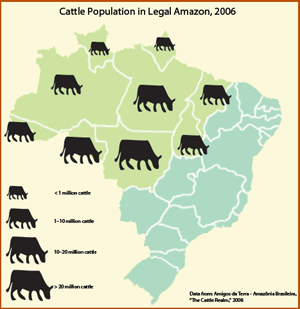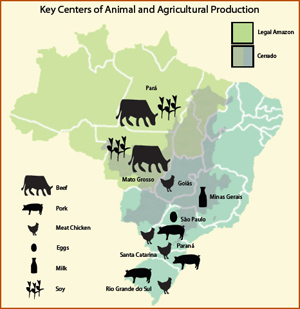Despite environmentalists’ efforts to combat “rainforest beef” in the 1980s, pasture expansion for cattle is still the primary cause of deforestation in the Brazilian Amazon, says a new report produced by Brighter Green.
While Brazil’s investments in agribusiness have made it an agricultural powerhouse—the country is now the world’s third-largest exporter of farm commodities after the US and the European Union—unfortunately, two of the Brazil’s key products, cattle and soy, are still driving deforestation as well as economic growth. According to Brighter Green’s report, researchers estimate that cattle ranching caused 65-70 percent of land clearing in the Amazon between 2000 and 2005.
Brazil is advancing dual goals–the protection of its rich biodiversity and economic expansion–without integrating its policy, according to Brighter Green. The study finds that Brazil may be unable to meet its climate change goals through rainforest protection while simultaneously allowing clearing in the Amazon for cattle pasture and soy cultivation.
|

Head of cattle in the Amazon. Image courtesy of Brighter Green, based on data from Amigos da Terra—Amazônia. Click image to enlarge.
|
At the 2008 UN Climate Change Summit in Poland, former Brazilian president Lula promised that Brazil would cut its deforestation levels 72 percent by 2018. However, Brazil also set an additional goal for 2018: to double the size of the country’s cattle herd. Brazil’s former Minister of the Environment, Carlos Minc, stated that the cattle sector cleared at least 12,900 square kilometers (5,000 square miles) of rainforest in a single year between July 2007 and July 2008. Greenpeace estimates that cattle occupied 80 percent of deforested land in the Legal Amazon, excluding Maranhão state, in 2006.
According to the World Bank, deforestation lowered Brazil’s carbon stocks by 6 billion metric tons in the decade leading up to 2010, making Brazil the world’s fourth-largest emitter of greenhouse gases, largely due to runaway rainforest clearing. But Brazil’s government has pledged to reduce greenhouse gas emission 40 percent from projected levels by 2020. The Brighter Green study found that 75 percent of Brazil’s emissions result from land-use changes, including deforestation, that occur in the drive of agricultural expansion. Meanwhile, Brazil’s National Institute for Space Research (INPE) and Friends of the Earth-Amazonia (Amigos da Terra—Amazônia) estimate that nearly half of Brazil’s emissions came from cattle between 2003 and 2008.
|

Head of cattle in the Amazon. Image courtesy of Brighter Green, based on data from Amigos da Terra—Amazônia. Click image to enlarge.
|
This led researchers at the University of São Paulo, cited in the Brighter Green study, to determine that, “Besides effort to curb emissions from the energy and deforestation sectors, it is now a top priority to implement a national program to incentives mitigation efforts concerning the agricultural sectors.”
This may be easier said than done, as Brazil’s agribusiness is hugely linked to the dominant economic and political interests. In 2008, Brazil’s agribusiness sector accounted for a quarter of the country’s GDP, and agricultural products made up 35 percent of the country’s exports. Meat and soy, largely grown on formerly forested land and the threatened Cerrado grassland ecosystem, brought in half of Brazil’s agricultural export earnings, valued at $71.8 billion in 2008. Brazil exports beef to nearly 100 countries, supplying 25 percent of the global market. However, the majority of Brazilian beef is consumed domestically: 7.2 of the 9 million metric tons of beef in 2009 with per capita meat consumption growing 12 percent between 1997 and 2007.
Katia Toralles, an anthropologist and dairy farmer in Goiás state, says that the Brazilian government is not united in its environmental and social policy: the Ministers of Environment and Agrarian Reform maintain a “progressive understanding of environmental issues and their relation to farming practices…[but] in terms of where the money and power are, that’s the Ministry of Agriculture, Livestock and Food Supply, and that’s basically the big guys in agribusiness, as is Congress.”
The Brighter Green report finds that Brazil’s focus on agribusiness, in addition promotion of ecologically-damaging methods and rainforest clearing is worsening Brazil’s extreme rural inequality, thus inhibiting overall development in the Amazon, a region that lags in development indicators. Brazil’s cattle industry employs, on average, only one person for every 700 cattle, claims João Filho, an fifth-generation rancher who now runs the environmental Instituto Peabiru in Pará state, contributing to rural unemployment and overwhelming rural-urban migration.
In 2008, Brazil’s Agriculture and Livestock Plan offered R 65 billion ($36.6 billion) in credit to farmers and ranchers, but only R 10 billion was offered to small and family farmers, who lack the extension services that would help them rehabilitate land rather than clear more forest. The 2010 Agricultural and Livestock Plan doubled credit to producers, but 86 percent was directed to commercial agriculture, while small farmers were promised a smaller percentage than even previously, less than 14 percent.

